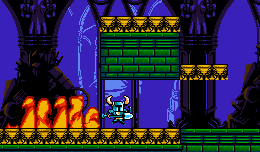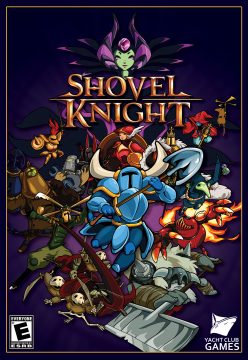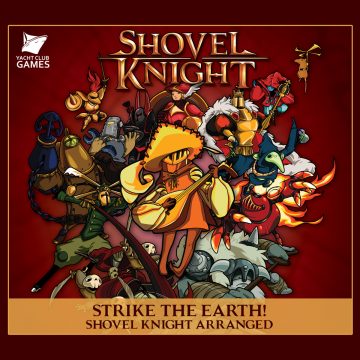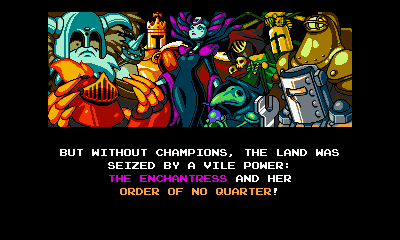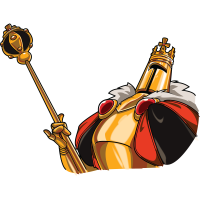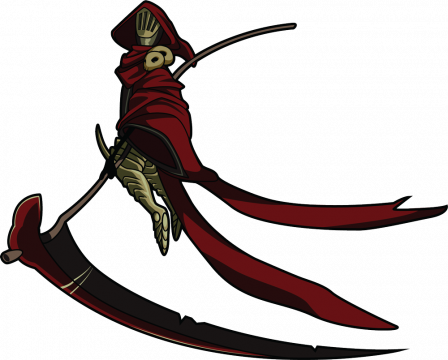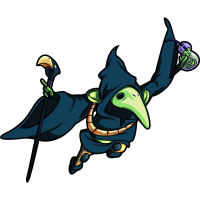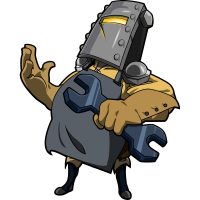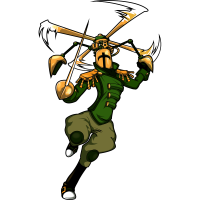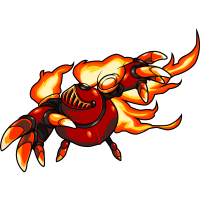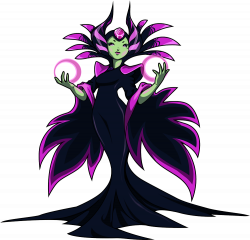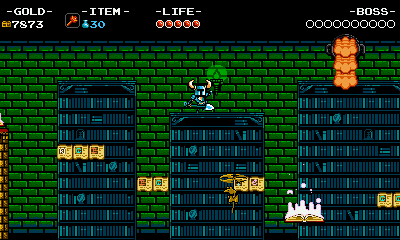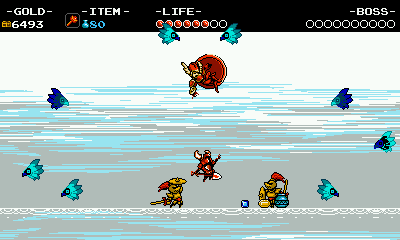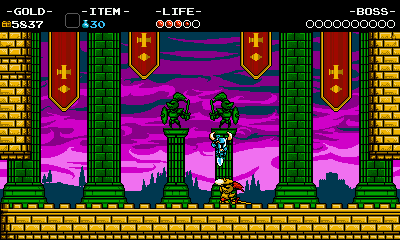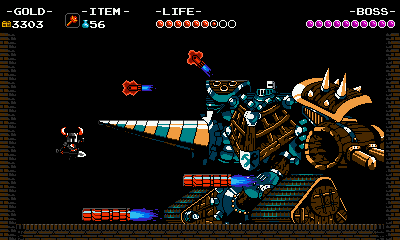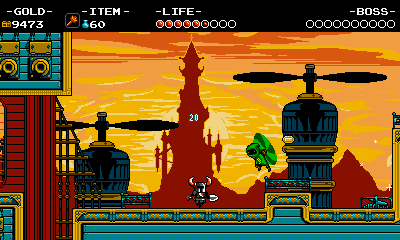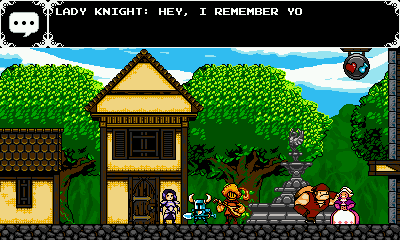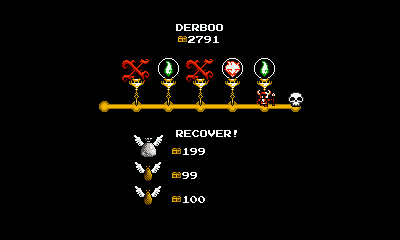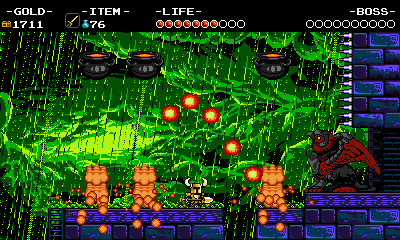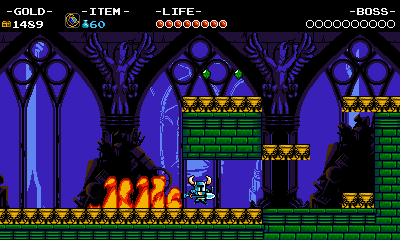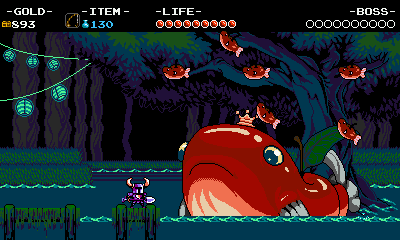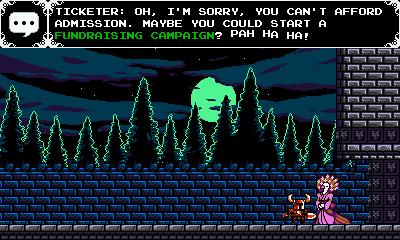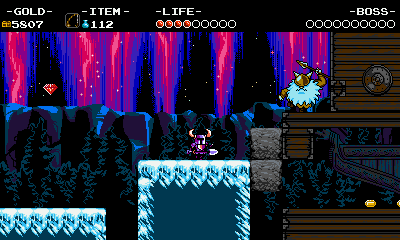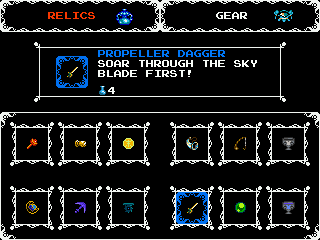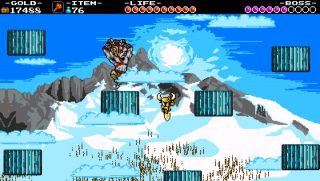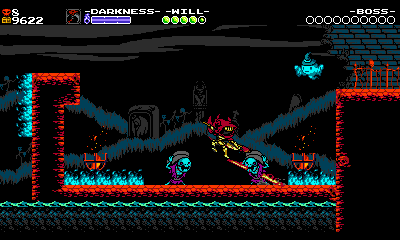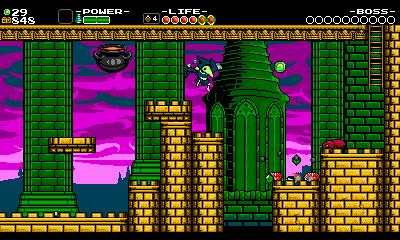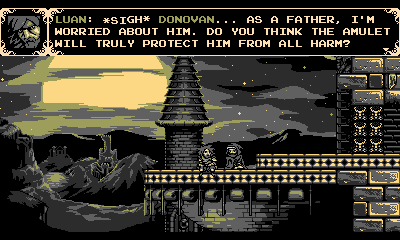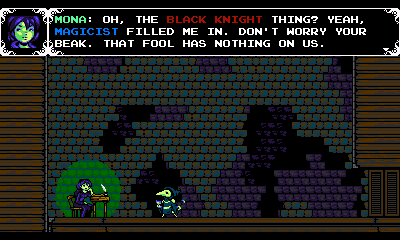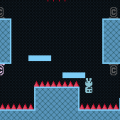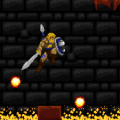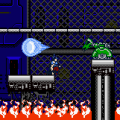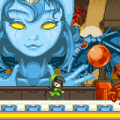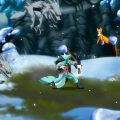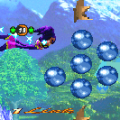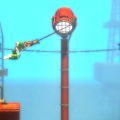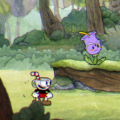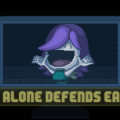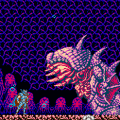It’s easy to look at Shovel Knight as yet another indie “nostalgia game” dedicated to revisiting and monetizing your childhood. Its derivative elements are clear – at its core, it looks and feels like a Mega Man game, but it borrows the sword swinging (and bouncing) of Zelda 2 combat and Castlevania subweapons, with a Super Mario Bros. 3 world map. These elements certainly make the game fun, and they’re executed quite well, but they’re hardly enough to make the game fun on their own. Shovel Knight, however, builds an unmistakably modern game on these classic foundations, and the end result is a polished, fun, and surprisingly new experience.
Shovel Knight was funded by a Kickstarter campaign in April 2013 and released in June 2014 for Windows, Wii U, and 3DS, then for Mac that September and Linux in October. It is the first game by indie studio Yacht Club Games, which has a number of key former employees of WayForward Technologies (best known for Nintendo remakes, Disney games, and Shantae), including the designer Sean Velasco and audio designer Jake Kaufman.
The plot, as laid out in the opening cutscene: In an age of adventurers, two inseparable heroes, Shovel Knight and Shield Knight, come across a cursed amulet in the Tower of Fate which whisks Shield Knight away with evil magic. Shovel Knight, despondent, turns to a life of pastoral solitude, and in his absence a villainous Enchantress seizes power with her eight knights, the Order of No Quarter. Shovel Knight sets out to defeat the Order and reach the Tower of Fate, hoping to learn of what happened to Shield Knight.
The Order of No Quarter
King Knight
Arrogant and materialistic, King Knight holds the throne of Pridemoor Keep, its original king ousted by the Enchantress. The image of power he maintains far surpasses the power he wields in battle, however; he serves more as a warm-up to later boss battles.
Specter Knight
A scythe-wielding, undead necromancer inhabiting the Lich Yard. Terribly aware of mortality, he has been loyal to the Enchantress ever since she granted him an afterlife as a phantom. During his battle, he hovers, teleports, and throws his scythe much like Castlevania’s Death. For an opponent placed so early on in the game, he is one of Shovel Knight‘s most challenging bosses.
Plague Knight
A mad scientist completing research in the labs of the Explodatorium, a highly destructible stage playing on the danger of Shovel Knight’s ability to dig through walls and platforms. As volatile as his flasks of explosive chemicals, his movements during battle are highly unpredictable.
Treasure Knight
Laying claim to all the seas from his underwater vessel, the Iron Whale, Treasure Knight spends his time searching for ancient relics. His greed knows no bounds, but he points out that Shovel Knight is no less greedy for the gold he collects during his quest…
Tinker Knight
More of a mechanic than a fighter, Tinker Knight is significantly smaller and less threatening than the rest of the Order, though he can still use his wrench to put up a fight. However, once defeated, he enters his Tinker Tank, a massive war machine better suited to the task of crushing Shovel Knight.
Propeller Knight
The most agile of the Order, with a helicopter-bladed helmet as well as a massive Flying Machine. Propeller Knight flies across the deck of his ship and fences against Shovel Knight, assisted by his ship’s cannon fire.
Mole Knight
Hidden deep below the earth in the ruins of a Lost City, Mole Knight rather outclasses Shovel Knight in the digging department. His claws tear apart the earth and he burrows through tunnels with ease. He’s a dangerous force, burrowing through the walls of his boss arena faster as he takes more damage.
Polar Knight
The largest and most imposing member of the Order, he guards a shipwrecked vessel in the frozen tundra with his snow shovel. His size and armor make him an intimidating foe, and during his battle he can tear up the arena to reveal instant-kill spikes along the floor. He has some shared past with Shovel Knight, though it is not elaborated upon during the game.
The Enchantress
The leader and the one behind everything.
The Order of No Quarter provides a logical structure to the game, just like the Robot Masters in Mega Man: each knight in the Order awaits Shovel Knight at the end of an appropriately-themed stage on the world map. Plague Knight, a mischievous chemist, has a laboratory-themed stage with exploding enemies and destructible platforms. Propeller Knight is fought on his airship, of which the propellers and engines serve as the stage hazards, blowing Shovel Knight across pits and into enemies. The knights of the Order flesh out the tone of the game world with their backstories and dialogue.
Though the plot is simple, it is delivered in a variety of ways, along the spectrum of classic and modern. The expository cut scene at the beginning is a recognizable NES trope, simple and segregated from the gameplay. Then, just before each boss battle, Shovel Knight trades dialogue with his opponent, much like in the later Mega Man X titles. Finally, Shovel Knight also experiments with a more modern kind of storytelling unique to the medium of video games. After every few stages, Shovel Knight is shown dreaming about Shield Knight falling from the sky. Text tells you to ~SAVE HER!~ as enemies close in from all sides. When she enters the frame, Shovel Knight reaches toward her, and even if you manage to catch her, she disappears and the dream ends. This kind of scene fills you with a kind of powerlessness that games are especially good at delivering.
To provide a sense of progression, the stages are unlocked in tiers of 2-3 stages at a time, each tier on a further part of the world map. The difficulty can be a little uneven within one tier, particularly between the beginning pair of the incredibly easy King Knight and the rather tough Specter Knight. But overall, this kind of progression places easier, more traditional stages at the beginning, saving stages with more difficult and outlandish conceits for the end.
That said, the boss battles are definitely a highlight of the game. They’re challenging and tense, with a very good variety of attack patterns. When a boss’s health gets low, its attack patterns become much more dangerous – Propeller Knight’s cannons destroy parts of the floor and takes to the skies, for example. In addition to the knights of the Order, there are a few bosses who wander across the world map, like Mario 3‘s Hammer Bros. These bosses are still very fun to fight, but they feel less polished than the stage bosses; their designs are less interesting, and they generally seem more vulnerable to repetitions of the same kind of attack. Finally, there are recurring battles with the Black Knight, Shovel Knight’s rival, working with the Enchantress for an unknown reason. Since he wields a shovel as well, he feels particularly well-matched against Shovel Knight, and it’s fun to see him grow more powerful over the course of the game alongside you.
But beyond increasing difficulty through tougher bosses and trickier jumps, Shovel Knight’s most compelling innovations in its fluid difficulty and risk. The stages are full of gold and treasure, small pieces on the way to the boss and larger caches after challenging or hidden sections. These are rewarding in themselves, but the player can also visit two towns on the world map to buy health and magic upgrades, shovel techniques, and different armors. The shovel and armor “upgrades” do not merely augment Shovel Knight’s abilities, but allow the player to try a different playstyle: one armor increases magic, but decreases protection; one shovel technique lets Shovel Knight charge up a powerful slash, but slows him down while charging.
Death is handled in an especially interesting way. There are no lives in Shovel Knight. Rather, when he dies, he drops a percentage of his accumulated gold around the screen, where it will remain during his next life. This dropped gold serves as an incentive to get at least a little further each time. There’s no danger of losing all your lives and needing to restart after an arbitrary number of losses, but holding onto hoarded gold is a strong incentive to learn the stage layouts and boss battles.
Playing into the risk-management of deaths is the game’s flexible checkpoint system. The checkpoints are glass spheres filled with a certain amount of gold; you can either activate them to respawn there when you die, or you can smash them and take their gold. Appropriately, the most valuable checkpoints are placed right before tricky platforming sections and bosses. If you’re confident enough to break every checkpoint, there are huge rewards, but one unlucky step will send the Knight to the beginning of the level, with most of his gold floating precariously over a part he may never reach in his next life.
The levels are full of hidden goodies – at the end of any hidden room can lay a chest full of gold, or something more compelling. Chester, an adventurous salesman named for the chests he hides himself in, offers the relics he finds inside – for a steep price. Relics can be equipped to grant Shovel Knight the use of ranged magic spells, a much-needed way of attacking from a distance for a primarily melee game. Also hidden in the stages are music sheets, which can be turned in to a bard in the first town to access the game’s sound test, one song at a time, in addition to a gold reward.
The music was composed with the chiptune tracker FamiTracker, which emulates the NES’s sound hardware, but uses the expanded channels and instruments provided with Konami’s VRC6 sound chip, which was used in a few Japan-exclusive games like Akumajou Densetsu (Castlevania III). The game’s sounds are satisfying and the music is great, capturing the energy and catchy melodies of the more memorable NES soundtracks. A few more modern pieces of sound design are particularly nice touches to the game: each boss has their own unique battle theme, based on melodies from their stage’s theme, and the town music dynamically adjusts depending on whether you’re inside or outside, like in Banjo-Kazooie.
To understand Shovel Knight’s relationship to the NES games it draws from, the graphics provide an apt lens for the rest of the game. The game’s art is fantastic – the character sprites convey plenty of personality, and the backgrounds are intricately detailed. And though it is all accomplished through pixel art reminiscent of NES games, Shovel Knight‘s graphics are far more intensive than would be possible on an NES. The backgrounds have many layers of parallax, which look particularly good in outdoor areas, and even moreso in the stereoscopic 3D of the 3DS version. The game is tailored to modern widescreen monitors, yet it maintains the same number of vertical tiles as many typical NES games, which gives the Knight’s motion the same responsiveness and feel as, say, Mega Man’s. Yacht Club Games placed emphasis on recreating the feeling of old-school games without necessarily respecting the inessential limitations of the medium.
The game also avoids a common pitfall of nostalgia games by tactfully handling outside references. Though the game may contain elements of gameplay and structure that are clearly inspired by other games, such as the Zelda II towns and ambulatory townsfolk, there are no bits of “clever” referential dialogue or direct appearances of outside characters. Rather, the game’s universe stands on its own as quirky, charming, and self-contained, with bizarre and fun characters.
Shovel Knight‘s New Game+ feature is a little disappointing – you can play through again with all of your health, magic, armor, relics, and gold, ostensibly in a more difficult version of the game, but the difficulty is not very interesting. Enemies deal double damage, most health-restoring food is replaced with bombs, and most checkpoints are removed. The self-imposed challenges suggested in the game’s Feats (achievements), such as speedruns, minimum-health runs, and shovel-only runs, are generally more fun than the numerical difficulty applied in a New Game+ file.
There are a few minor differences between the PC, 3DS, and Wii U versions of the game. Both the 3DS and Wii U versions utilize the second screen for a relics menu, allowing a quick and unobtrusive way to switch weapons in a way that makes the PC version’s pause menu seem clunky in comparison. The 3DS version’s graphics, of course, pop out a bit more with stereoscopic 3D. In the Wii U version, the Digger’s Diary allows players to leave messages for other players in stages, to offer tips and share grievances about sadistically-placed bottomless pits. The 3DS version uses StreetPass in the StreetPass Arena, an asynchronous multiplayer duel mode based on trying to predict the other player’s attack strategy.
Some of the versions have exclusive boss fights – the Xbox One version (and later the Windows 10/Steam version) have a fight with the Battletoads, of Rare’s famed action game series, while the Sony (PlayStation 3/4/Vita) have you fighting against Kratos from God of War. These appear as optional battles on the map and yield unique items when defeated.
Shovel Knight reached several Kickstarter goals for a whole ton of extra content, which was slowly developed and published as DLC over the years since its initial release. All were given out free for anyone who bought the game before a certain date, though they can be bought piecemeal, or as a whole big package, subtitled Treasure Trove.
The biggest draw are three new campaigns starring some of the Order of No Quarter: Plague Knight stars in Plague of Shadows, Specter Knight is featured in Specter of Torment, and King Knight is the protagonist of King of Cards. These aren’t just merely taking the characters and plopping them in Shovel Knight’s story mode, as they’ve been redesigned to take into account each of the knight’s abilities and storylines. The amount of reworking depends on the campaign – Plague Knight’s switches around things here and there and adds a handful of new tunes, while Specter Knight’s drastically reworks the levels, redesigns the boss fights, and includes a near-full soundtrack arrangement.
The stories themselves are completely new too – Plague Knight’s is sort of a side-story while Specter Knight’s is a prequel, detailing how all of the knights were drafted to join the Enchantress. Owing to his job, Plague Knight can’t actually enter towns on the world map but instead interacts with his minions via his secret underground lair that lies beneath them. Specter Knight simply hangs out in his castle and warps from area to area via a portal. The campfire scenes are also replaced in Specter Knight’s campaign with little playable vignettes detailing his time as a mortal.
Each has different types of offensive capabilities too, with Plague Knight attacking with bombs (whose properties can be tweaked with various ingredients) while Specter Knight attacks with a scythe. More interestingly, neither are as agile as Shovel Knight nor can they jump as high, but have a variety of other movement abilities. Plague Knight can trigger an explosion, propelling him a little farther and allowing him to jump again, while Specter Knight can run straight up walls, and can target both enemies and torches to execute a diagonal dash. Since these properties are so unique, even among other platformers, it takes awhile to get used to them, but it provides a significant challenge even for those who’ve already beaten the main game.
There are other significant additions too, including a gender swap mode, where you can change the look (and dialogue) of any of the game’s major characters to be male or female – for example, a female Shovel Knight rescues the male Shield Knight from the Enchanter and a female Order of No Quarter. The change in designs range from subtle to drastic, depending on the character, but it’s a great touch. Also added is a two-player co-op mode, as well as four-player Battle and Challenge modes.
Links:
Yacht Club Games – Shovel Knight – official developer site.
Official Kickstarter – contains early concepts and screenshots.
Gamasutra, “Breaking the NES for Shovel Knight“ – article detailing Shovel Knight‘s relationship with the NES’s games and hardware.
Bandcamp – Jake Kaufman’s Bandcamp page, with downloads for Shovel Knight‘s soundtrack and arranged soundtrack
